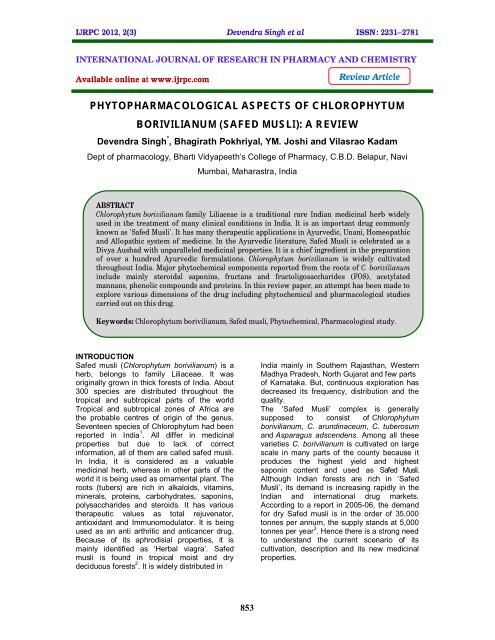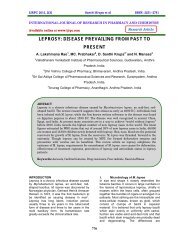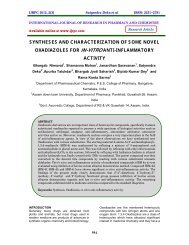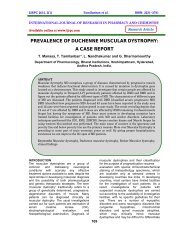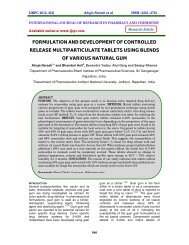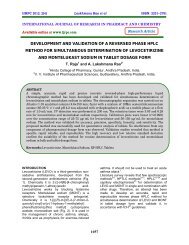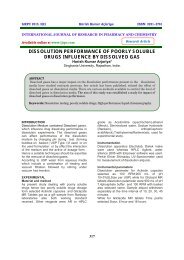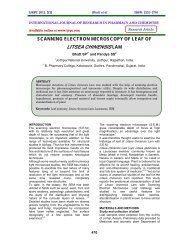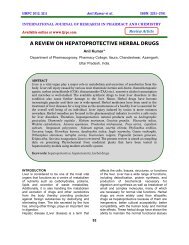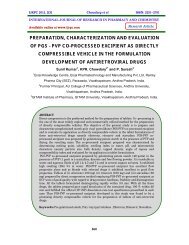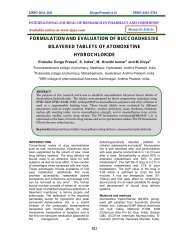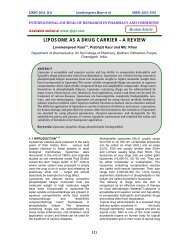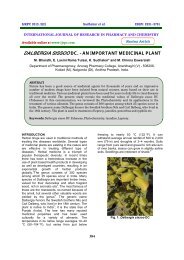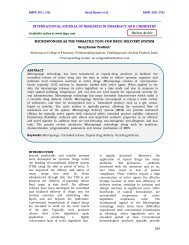(safed musli): a review - ijrpc
(safed musli): a review - ijrpc
(safed musli): a review - ijrpc
Create successful ePaper yourself
Turn your PDF publications into a flip-book with our unique Google optimized e-Paper software.
IJRPC 2012, 2(3) Devendra Singh et al ISSN: 22312781<br />
INTERNATIONAL JOURNAL OF RESEARCH IN PHARMACY AND CHEMISTRY<br />
Available online at www.<strong>ijrpc</strong>.com<br />
Review Article<br />
PHYTOPHARMACOLOGICAL ASPECTS OF CHLOROPHYTUM<br />
BORIVILIANUM (SAFED MUSLI): A REVIEW<br />
Devendra Singh * , Bhagirath Pokhriyal, YM. Joshi and Vilasrao Kadam<br />
Dept of pharmacology, Bharti Vidyapeeth’s College of Pharmacy, C.B.D. Belapur, Navi<br />
Mumbai, Maharastra, India<br />
ABSTRACT<br />
Chlorophytum borivilianum family Liliaceae is a traditional rare Indian medicinal herb widely<br />
used in the treatment of many clinical conditions in India. It is an important drug commonly<br />
known as 'Safed Musli'. It has many therapeutic applications in Ayurvedic, Unani, Homeopathic<br />
and Allopathic system of medicine. In the Ayurvedic literature, Safed Musli is celebrated as a<br />
Divya Aushad with unparalleled medicinal properties. It is a chief ingredient in the preparation<br />
of over a hundred Ayurvedic formulations. Chlorophytum borivilianum is widely cultivated<br />
throughout India. Major phytochemical components reported from the roots of C. borivilianum<br />
include mainly steroidal saponins, fructans and fructoligosaccharides (FOS), acetylated<br />
mannans, phenolic compounds and proteins. In this <strong>review</strong> paper, an attempt has been made to<br />
explore various dimensions of the drug including phytochemical and pharmacological studies<br />
carried out on this drug.<br />
Keywords: Chlorophytum borivilianum, Safed <strong>musli</strong>, Phytochemical, Pharmacological study.<br />
INTRODUCTION<br />
Safed <strong>musli</strong> (Chlorophytum borivilianum) is a<br />
herb, belongs to family Liliaceae. It was<br />
originally grown in thick forests of India. About<br />
300 species are distributed throughout the<br />
tropical and subtropical parts of the world<br />
Tropical and subtropical zones of Africa are<br />
the probable centres of origin of the genus.<br />
Seventeen species of Chlorophytum had been<br />
reported in India 1 . All differ in medicinal<br />
properties but due to lack of correct<br />
information, all of them are called <strong>safed</strong> <strong>musli</strong>.<br />
In India, it is considered as a valuable<br />
medicinal herb, whereas in other parts of the<br />
world it is being used as ornamental plant. The<br />
roots (tubers) are rich in alkaloids, vitamins,<br />
minerals, proteins, carbohydrates, saponins,<br />
polysaccharides and steroids. It has various<br />
therapeutic values as total rejuvenator,<br />
antioxidant and Immunomodulator. It is being<br />
used as an anti arthritic and anticancer drug.<br />
Because of its aphrodisial properties, it is<br />
mainly identified as ‘Herbal viagra’. Safed<br />
<strong>musli</strong> is found in tropical moist and dry<br />
deciduous forests 2 . It is widely distributed in<br />
India mainly in Southern Rajasthan, Western<br />
Madhya Pradesh, North Gujarat and few parts<br />
of Karnataka. But, continuous exploration has<br />
decreased its frequency, distribution and the<br />
quality.<br />
The ‘Safed Musli’ complex is generally<br />
supposed to consist of Chlorophytum<br />
borivilianum, C. arundinaceum, C. tuberosum<br />
and Asparagus adscendens. Among all these<br />
varieties C. borivilianum is cultivated on large<br />
scale in many parts of the county because it<br />
produces the highest yield and highest<br />
saponin content and used as Safed Musli.<br />
Although Indian forests are rich in ‘Safed<br />
Musli’, its demand is increasing rapidly in the<br />
Indian and international drug markets.<br />
According to a report in 2005-06, the demand<br />
for dry Safed <strong>musli</strong> is in the order of 35,000<br />
tonnes per annum, the supply stands at 5,000<br />
tonnes per year 3 . Hence there is a strong need<br />
to understand the current scenario of its<br />
cultivation, description and its new medicinal<br />
properties.<br />
853
IJRPC 2012, 2(3) Devendra Singh et al ISSN: 22312781<br />
Vernicular Name<br />
Sanskrit : Swetha <strong>musli</strong>.<br />
Hindi : Safed <strong>musli</strong>, Hazarmuli, Satmuli<br />
Gujrati : Ujli<strong>musli</strong>, Dholi musali<br />
Malyalam: Shedeveli, Shedheveli.<br />
Marathi : Safed <strong>musli</strong>, Sufed Musli, Kuli.<br />
Tamil : Tannirvittang, Tannirvittan-<br />
Kizhangu, Vipurutti,<br />
Taniravi thang<br />
Telgu : Tsallogadda, Swetha <strong>musli</strong>.<br />
Arabic : Shaqaqule-hindi<br />
Sinhalese : Hirtha-wariya, Mushali<br />
Garhwal : Jhirna<br />
U.P : Khairuwa<br />
Arabic : Shaqaqule.<br />
English : India spider plant, Spider plant<br />
(India), White musale.<br />
French : Chlorophytum medicinal<br />
Ayurvedic Description<br />
Botanical name: Chlorophytum borivilianum<br />
Sanskrit name : Swetha <strong>musli</strong><br />
Synonyms : Safed <strong>musli</strong><br />
Properties :<br />
Rasa : Sweet, Bitter<br />
Guna : Moist, Unctuous,<br />
Heavy Virya : Cold<br />
Vipaka<br />
: (post-digestive effect):<br />
Sweet 4,5 .<br />
Traditional uses<br />
Traditionally, tubers are used in the treatment<br />
of rheumatism and the leaves as vegetable in<br />
various culinary preparations. It is traditionally<br />
used for its aphrodisial properties in lack of<br />
libido male impotency, oligospermia. It is also<br />
widely used as a general health promotive<br />
tonic and for delaying the ageing process.<br />
Dried root powder increases the lactation<br />
amongst the feeding mothers and lactating<br />
cows. It also removes the knee pains within a<br />
week if taken daily with milk 6,7 . Leaves are<br />
eaten by the tribal people of Western Ghats as<br />
an expectorant. In the traditional diet of<br />
nursing mothers (after confinement) its powder<br />
is added in the preparation of laddoos (sweet<br />
prepared in ball form) to be taken as a<br />
energizing food. Efforts are on in countries like<br />
the USA and England to make chips/flakes<br />
with the tubers to use it as a nutritious item in<br />
breakfast. C. borivilianum has been described<br />
in ancient Indian literature such as<br />
Bhavaprakash nighantu, Rasendra<br />
Sarsangrah, Raja Ballabh Nighantu as<br />
‘Vajikaran’ or aphrodisiac. The roots of C.<br />
borivilianum are a constituent of<br />
‘Chyawanprash’ an outstanding rejuvenator 8 . It<br />
is known as the Indian Ginseng 9 , because of<br />
great therapeutic importance and its tubers are<br />
the major constituents of more than 100<br />
ayurvedic preparations 10 .<br />
Cultivation<br />
In India, it is cultivated in parts of Gujarat,<br />
Maharashtra, Rajasthan, Madhya Pradesh,<br />
Chhattisgarh, Uttar Pradesh, Haryana and<br />
Karnataka in tropical and sub tropical climates<br />
with altitudes up to 1500m. It is being grown<br />
on an area more than 400 hectares for its<br />
tuberous roots 11 and also grows naturally in<br />
most forest parts of central India where<br />
climatic conditions are suitable. This plant can<br />
grow well in a range of temperature and<br />
rainfall conditions. A sandy loamy soil with<br />
adequate drainage is ideal for its production.<br />
Normal pH range 6 to 7, higher dose of super<br />
phosphate, decomposed farmyard manure and<br />
good drainage system facilitates better tuber<br />
growth. It is usually found in soils rich in<br />
organic matter and requires bright sunlight 5 .<br />
Cultivation of Safed <strong>musli</strong> usually begins in the<br />
month of April/May. After the field is prepared,<br />
Safed <strong>musli</strong> is sown with the onset of the<br />
monsoon. Bavastin treated Fingers are<br />
separated and planted at a distance of about<br />
25 cm within the row. The planting density is<br />
about 80,000 fingers per hectare, weighing<br />
approximately 400-500 kg. Leaves turn yellow<br />
and fall off after 3.0 to 3.5 months, but they are<br />
left in the field for some more time and<br />
moisture content is maintained for ripening<br />
which increases their medicinal properties.<br />
The skin of the tubers turns dark brown by<br />
January-February when they are ready for<br />
harvest. Mature tubers should be dug out, long<br />
healthy fingers that detach naturally from the<br />
tubers are processed by peeling off the skin of<br />
the fingers with a stainless steel knife and sun<br />
drying for 3 - 4 days. They are then packaged<br />
in polythene bags and transported for<br />
marketing 12 .<br />
Morphology and Microscopy<br />
Safed <strong>musli</strong> is a tiny annual herb that grows<br />
well in tropical and sub-tropical climates with<br />
altitudes upto 1500m. It grows to a maximum<br />
height of 1.5 ft. Tubers can grow upto a depth<br />
of 10inches. Fig.1 Whole plant of C.<br />
borivilianum.<br />
Root<br />
Roots pale brown to white colour with<br />
characteristic odour and are tasteless in<br />
nature. Root tubers are fleshy, fascicled and<br />
directly originate from the stem disc devoid of<br />
any fibrous structure and distinguished it from<br />
other species of Chlorophytum genus. The<br />
shape of tubers were cylindrical, the thickness<br />
854
IJRPC 2012, 2(3) Devendra Singh et al ISSN: 22312781<br />
being on the average 0.9 cm and the length<br />
8cm.The number of tubers varies from plant to<br />
plant and on an average 5-30 tubers/ plant are<br />
observed and slightly tapering towards lower<br />
side look like pestle. Fig.2 Roots of C.<br />
borivilianum<br />
Leafs<br />
It has 6 -13 radical leaves spirally imbricate at<br />
the base, sessile in nature, lanceolate and<br />
linear or ovate with acute apex and slightly<br />
narrowed at the base and less than 30cm long.<br />
The leaves spread horizontally, with smooth<br />
surfaces, wavy margins and parallel venation.<br />
Flowers and fruit<br />
Flowers of C. borivilianum are small, white,<br />
bracteate, pedicillate, zygomorphic usually<br />
arranged in alternate clusters, each cluster<br />
comprising of 3 flowers. The flower clusters<br />
are dense on the upper part of the scape;<br />
bracts are linear, papery and purplish, 1.0 -<br />
10.5cms long; pedicle whitish and 6 -10 mm<br />
long. It bears green to yellow coloured fruit<br />
which is almost equal in length and breadth.<br />
The seed is very small, black and enclosed in<br />
the holes. In one hole, there are about 10- 12<br />
seeds. Seeds are endospermic, onion like,<br />
black coloured and angular in shape 12 . Fig.3<br />
Flowers of C. borivilianum.<br />
Microscopy<br />
Microscopic characters of fresh entire tuberous<br />
root sample of C. borivilianum is as follows-<br />
Epidermis is present without cuticle & stomata,<br />
many unicellular root hairs. Cortex shows<br />
round parenchymaatous cells with<br />
intercellularr spaces. Starch is absent.<br />
Endodermis (50µm thick) shows barrel shaped<br />
closely arranged parenchymatous cell lies<br />
below the cortex & forms a ring. Single layered<br />
pericyclic cells are present below the<br />
endodermis which are Uniseriate & composed<br />
of thin walled parenchymatous cells.<br />
Numerous Xylem composed of a single<br />
layered round metaxylem towards the pith,<br />
protoxylem towards the periphery. Phloem<br />
Composed of companion cells and phloem<br />
parenchyma 13 . Powdered microscopy shows<br />
raphides of calcium oxalate, isolated single<br />
stone cells with simple pits on their walls and<br />
isolated and combined reticulate vessels 14 .<br />
Phytochemistry<br />
Major biochemical constituents of<br />
C. borivilianum are carbohydrates 42%,<br />
protein 10%, fibres 20 - 30%, saponins 2 -17%<br />
and alkaloids 15 - 25%. Primarily saponins and<br />
alkaloids impart medicinal value. It is a rich<br />
source of over 25 alkaloids, vitamins, proteins,<br />
carbohydrates, steroids, saponins, potassium,<br />
calcium, magnesium, phenol, resins, mucilage,<br />
and polysaccharides and also contains high<br />
quantity of simple sugars, mainly sucrose,<br />
glucose, fructose, galactose, mannose and<br />
xylose. Recently Stigmasterol and saponin<br />
named as furostanol and Chlorophytoside-I<br />
(3b, 5a, 22R, 25R)-26-(β-D-<br />
glucopyranosyloxy)-22-hydroxy-furostan-12-<br />
one-3yl O-β-D-galactopyranosyl (1-4)<br />
glucopyranoside has been isolated 15 .<br />
Pharmacological activity of Chlorophytum<br />
borivilianum<br />
‣ Aphrodisiac activity<br />
The aqueous extract of dried roots<br />
of C. borivilianum is reported to has a potent<br />
aphrodisiac and spermatogenic potential. To<br />
evaluate this effect, male wistar albino rats<br />
were orally treated with the dose of 125 and<br />
250mg/kg/day, their sexual behaviour was<br />
monitored 3 hr later using a receptive female.<br />
Their sexual behaviour was evaluated on days<br />
1, 7, 14, 21 and 28 of treatment by pairing with<br />
a pro-oestrous female rat. For sperm count the<br />
treatment was continued further in all groups<br />
(control group-dist. water and treated group<br />
except group with sidenafil citrate 4mg/kg/day)<br />
for 60 days. At 125 mg/kg, C. borivilianum<br />
group had a marked aphrodisiac action,<br />
increased libido, sexual vigor and sexual<br />
arousal as compared with other groups.<br />
Similarly, at the higher dose (250 mg/kg) all<br />
the parameters of sexual behaviour were<br />
enhanced, but showed a saturation effect after<br />
day 14. On day 60 the sperm count increased<br />
significantly in both the C. borivilianum groups,<br />
125 mg/kg and 250 mg/kg, in a dose<br />
dependent manner 16 .<br />
In another study, the effects of C. borivilianum<br />
(Cb) on sexual dysfunction, loss of body<br />
weight, and lack of libido in hyperglycemic rats<br />
induced with streptozotocin or alloxan was<br />
investigated. It was found that Cb extract<br />
treatment ameliorated the diabetes-induced<br />
dysfunction at 200 mg/kg dose. There was<br />
very low weight loss (P
IJRPC 2012, 2(3) Devendra Singh et al ISSN: 22312781<br />
effects on diabetes and its associated effects<br />
on sexual functionality 17 .<br />
‣ Immunomodulatory activity<br />
Polysaccharide fraction (CBP) of C.<br />
borivilianum has immunostimulating<br />
properties. CBP is derived from hot water<br />
extraction of C. borivilianum (Cb), comprising<br />
of ∼31% inulin-type fructans and ∼25%<br />
acetylated mannans (of hot water-soluble<br />
extract), was evaluated for its effect on natural<br />
killer (NK) cell activity (in vitro). Human<br />
peripheral blood mononuclear cells, isolated<br />
from whole blood were tested in the presence<br />
or absence of varying concentrations of each<br />
C. borivilianum fraction for modulation of NK<br />
cell cytotoxic activity toward K562 cells.<br />
Preliminary cytotoxicity evaluation against<br />
P388 cells was performed to establish noncytotoxic<br />
concentrations of the different<br />
fractions. Testing showed the observed<br />
significant stimulation of NK cell activity to be<br />
due to the CBP of C. borivilianum.<br />
Furthermore, in vivo evaluation carried out on<br />
Wistar strain albino rats for humoral response<br />
to sheep red blood cells and immunoglobulinlevel<br />
determination using enzyme-linked<br />
immunosorbent assay (ELISA), exhibited an<br />
effectiveness of C. borivilianum aqueous<br />
extract in improving immune function. Thus,<br />
results provide useful information for<br />
understanding the role of CBP in modulating<br />
immune function 18 .<br />
‣ Anthelmintic activity<br />
Saponin extract of C. borivilianum has<br />
Anthelmintic property when checked against<br />
Pheretima posthuma and Ascardia galli. He<br />
used methanolic extract, crude saponin extract<br />
and purified saponin extract, Piperazine as<br />
standard drug and dist Water as control.<br />
Parameters used were time of paralysis and<br />
time of death of the worm. All extracts showed<br />
significant anthelmintic activity on selected<br />
worms. Purified saponin extract was found<br />
more active than other extracts 19 .<br />
‣ Antioxidant activity<br />
Antioxidant activity of aqueous extract of C.<br />
borivilianum (250 mg/kg for 7 days) was<br />
studied by 1, 1-diphenyl-2-picrylhydrazyl<br />
(DPPH) free radical scavenging assay and<br />
lipid peroxidation assay. The aqueous extract<br />
of C. borivilianum (250 mg/kg for 7 days)<br />
inhibits significantly the levels of DPPH free<br />
radicals and thiobarbituric acid reactive<br />
substances, respectively in a dose-dependent<br />
manner 16 .<br />
Antioxidant activity of C. borivilianum root<br />
extract was again proved using<br />
chemicals/metals-mediated oxidation.<br />
Aqueous extract, when used in graded-dose<br />
(25 to 1000 µg/ml), exhibits a very good<br />
antioxidant potency as evidenced by powerful<br />
nitric oxide, superoxide, hydroxyl, DPPH and<br />
ABTS [2, 20-azinobis (3-ethylbenzothiazoline-<br />
6- sulfonic acid)] radicals scavenging activity<br />
along with reducing capacity (ferricyanide<br />
couple assays), metal chelating ability, as well<br />
as markedly suppressed the lipid peroxidation<br />
in mitochondrial fractions. Further, aqueous<br />
extract significantly decreased (P < 0.05)<br />
copper-mediated human serum and kinetics of<br />
LDL oxidation 20 .<br />
Significant increase (p
IJRPC 2012, 2(3) Devendra Singh et al ISSN: 22312781<br />
incidence, tumour burden, tumour size and<br />
tumour weight and significant (p
IJRPC 2012, 2(3) Devendra Singh et al ISSN: 22312781<br />
Fig. 3: Flowers of C. borivilianum<br />
REFERENCES<br />
1. Oudhia P. My experiences with<br />
wonder crop Safed Moosli. In:<br />
Souvenir. International Seminar on<br />
Medicinal Plants and Quality<br />
Standardization, VHERDS, Chennai,<br />
2001.<br />
2. Thakur GS, Bag M, Sanodiya<br />
BS, Debnath<br />
M, Zacharia<br />
A, Bhadauriya P, Prasad GB<br />
and Bisen<br />
PS.<br />
Chlorophytum borivilianum: a white<br />
gold for biopharmaceuticals and<br />
neutraceuticals. Curr Pharm<br />
Biotechnol. 2009; 10(7):650-66.<br />
3. www.agricare.org<br />
4. Toth K, Haapala T and Hohtola A.<br />
Alleviation of browning in oak explants<br />
by chemical pretreatments. Biologia<br />
Plantarum 1994;36:511-517<br />
5. Paques M. and Boxus PA. model to<br />
learn 'vitrification', the root stock apple<br />
M.26. Present results. Acta<br />
Horticulturae 1987;212:193-219.<br />
6. Elizabeth KG. Safed <strong>musli</strong> A promising<br />
medicinal plant. Indian Journal of<br />
Arecanut, Spices and Medicinal<br />
Plants. 2001;5 (2):65-69.<br />
7. Singh A and Chauhan HS. Safed<br />
<strong>musli</strong> (Chlorophytum borivilianum)<br />
distribution, biodiversity and<br />
cultivation. Journal of Medicinal and<br />
Aromatic Plant Sciences. 2003; 25<br />
:712-719.<br />
8. Haque R, Saha1 S and Bera T. Peer<br />
Reviewed Literature on medicinal<br />
activity of Chlorophytum borivilianum<br />
Commercial Medicinal Plant. Int J<br />
Drug Dev & Res. 2011;3(1):1116-<br />
1130.<br />
9. Singhania, A. Biovedic cultivation of<br />
<strong>safed</strong> <strong>musli</strong> (Chlorophytum<br />
borivilianum) Agrobios Newsletter,<br />
2003;3 :22<br />
10. Oudhia P. Problems perceived by<br />
Safed <strong>musli</strong> (Chlorophytum<br />
borivilianum) growers of Chattisgarh<br />
(India) region : A study. Journal of<br />
Medicinal and Aromatic Plants,<br />
2000;22:13-18<br />
11. Kothari SK and Singh K. Production<br />
technique for the cultivation of <strong>safed</strong><br />
<strong>musli</strong> (Chlorophytum borivilianum). J<br />
Horticulture Sci Biotech.<br />
2003;78(2):261-264.<br />
12. Haque R, Saha1 S and Bera T. A Peer<br />
Reviewed of General Literature on<br />
Chlorophytum<br />
borivilianum<br />
Commercial Medicinal Plant., Int. J.<br />
Drug Dev. & Res., 2011;3(1):165-177.<br />
13. Panda SK, Das D and Tripathy NK.<br />
Botanical studies of plants sold in<br />
market as ‘<strong>safed</strong> <strong>musli</strong>’.<br />
IJPRD:2011;3(1):001.<br />
14. Chakraborthy GS and Aeri V.<br />
Pharacognostical studies of potential<br />
herb- Chlorophytum borivilianum.<br />
IJPSR. 2010; 1(4):89-95.<br />
15. Deore SL and Khadabadi SS. Isolation<br />
and characterization of<br />
phytoconstituents from Chlorophytum<br />
borivilianum. Phcog Res. 2010:2:343-<br />
9.<br />
16. Kenjale RD, Shah RK and Sathaye<br />
SS. Anti-stress and anti-oxidant<br />
effects of roots of Chlorophytum<br />
borivilianum (Santa Pau &<br />
Fernandes). Indian J Exp Biol.2007;<br />
45(11):974-9.<br />
17. Thakur GS, Bag M, Sanodiya<br />
BS, Debnath<br />
M, Zacharia<br />
A, Bhadauriya P, Prasad GB<br />
and Bisen<br />
PS.<br />
Chlorophytum borivilianum: a white<br />
gold for biopharmaceuticals and<br />
neutraceuticals. Curr Pharm<br />
Biotechnol. 2009;10(7):650-66.<br />
18. Thakur M. Paul C. Myrna A, Carol M<br />
and Vinod K. Immunomodulatory<br />
Polysaccharide from Chlorophytum<br />
borivilianum Roots Hindawi Publishing<br />
Corporation Evidence-Based<br />
Complementary and Alternative<br />
Medicine Volume. 2011.<br />
19. Deore SL and Khadabadi SS. In-vitro<br />
anthelmintic studies of Chlorophytum<br />
borivilianum. Ind jou of Nat Prod and<br />
Resources. 2010:1:1;53-56.<br />
20. Visavadiya NP, Soni B, Dalwadi N and<br />
Madamwar D.<br />
Chlorophytum borivilianum as<br />
potential terminator of free radicals in<br />
various in vitro oxidation systems.<br />
Drug Chem Toxicol. 2010;33(2):173-<br />
82.<br />
858
IJRPC 2012, 2(3) Devendra Singh et al ISSN: 22312781<br />
21. Kumar M, Meena P, Verma S, Kumar<br />
M and Kumar A. Anti-tumour, antimutagenic<br />
and chemomodulatory<br />
potential<br />
of Chlorophytum borivilianum. Asian<br />
Pac J Cancer Prev. 2010;11(2):327-<br />
34.<br />
22. Deore SL and Khadabadi SS.<br />
Screening of antistress properties of<br />
Chlorophytum<br />
borivilianum<br />
Pharmacologyonline. 2009;1:320-328<br />
23. Mimaki Y, Kammoto T and Sashida Y.<br />
Steroidal Saponins from the<br />
underground parts of Chlorophytum<br />
and their inhibitory activity on tumor<br />
promoter-induced phospholipids<br />
metabolism of Hela cells.<br />
Phytochemistry. 1996;41:1405-10.<br />
24. Qiu SX, Li XC and Xiong Y. Isolation<br />
and characterization of cytotoxic<br />
saponin Chloromaloside -A from<br />
Chlorophytum. Planta Med. 2000;<br />
66:587-90.<br />
25. Acharya D, Mitaine-Offer AC, Kaushik<br />
N, Miyamoto T, Paululat T, Mirjolet<br />
JF, Duchamp O and Lacaille-Dubois<br />
MA. Cytotoxic spirostane-type<br />
saponins from the roots<br />
of Chlorophytum borivilianum. J Nat<br />
Prod. 2009;72(1):177-81.<br />
26. Narasimhan S, Govindarajan<br />
R, Madhavan V, Thakur M, Dixit<br />
VK, Mehrotra S and Madhusudanan<br />
KP. Action of (2-->1) Fructooligopolysaccharide<br />
fraction<br />
of Chlorophytum borivilianum against<br />
Streptozotocin-Induced oxidative<br />
stress. Planta Med. 2006;72(15):1421-<br />
4.<br />
27. Dabur R, Gupta A, Mandal TK, Singh<br />
DD, Bajpai V, Gurav AM and Lavekar<br />
GS. Antimicrobial activity of some<br />
Indian medicinal plants. Afr J Tradit<br />
Complement<br />
Altern<br />
Med. 2007;16;4(3):313-8<br />
28. Deore SL and Khadabadi SS.<br />
Larvicidal activity of the saponin<br />
fractions of Chlorophytum<br />
borivilianum. Journal of Entomology<br />
and Nematology. 2009;1(5);064-066.<br />
29. Goel A, Dash S, Gupta D, Pillai A and<br />
Yadav S. Antiviral activity of few<br />
selected indigenous plants against<br />
Bovine Herpes Virus-1;Journal of<br />
Immunology and Immunopathology.<br />
2011;13(1):30- 37.<br />
30. Sundaran S, Dwivedi P and Purwar S,<br />
Antibacterial activity of crude extract of<br />
Chlorophytum borivilianum to Bacterial<br />
pathogens. Res J of med Plant. 2011;<br />
1-5.<br />
859


